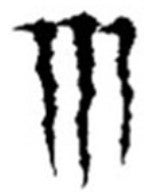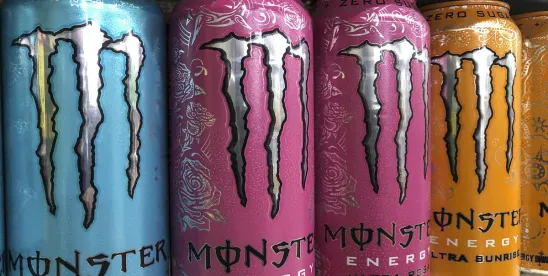Monster Energy managed to beat Bang Energy in Florida District Court last year, but it’s had some difficulties before the Trademark Trial and Appeal Board (the “TTAB”). Monster Energy is a leader in energy drinks, having a large share of the market, and its claw mark logo, a stylized M, is well known for energy drinks, both by itself and with the MONSTER word mark:

(the “Claw Mark”)
But twice in the past year, Monster’s attempts to prevent registration of other claw-mark marks have failed, and the TTAB’s reasoning in both cases is a primer on the difference between being well-known in one sector, and being famous enough to have strong rights with a wide variety of goods and services or to be protected from dilution.
Monster Energy Co. v. Maple Leaf Sports & Ent. Ltd. and NBA Props., Inc. Opp. No. 91222422 (TTAB May 3, 2021)
Last year, the TTAB found in favor of the owners of the Toronto Raptors and the NBA when Monster opposed registration of four marks for a variety of goods including merchandise and apparel:

Before addressing the similarity of the marks, the TTAB addressed the commercial strength of Monster’s Claw Mark, and found that while it was well-known, strong, and famous in connection with energy drinks and extreme sports, that strength and fame did not extend to any other goods and services for which Monster used the Claw Mark or had a registration, such as apparel and merchandise. Similarly, the TTAB found that the Claw Mark was famous for energy drinks, but did not have the general fame with the entire consuming public that would support a dilution claim by Monster.
After assessing the strength of the Claw Mark, the TTAB then found that the Claw Mark and the applied-for marks were not similar enough to cause a likelihood of confusion. They noted that the Claw Mark was simply that, while the applied-for marks represented basketballs and stars that had claw marks on them. Based on the limited strength of the Claw Mark with respect to the applied-for goods and services and the dissimilarity of the marks, the TTAB found for applicants.
Monster Energy Co. v. Jamal Jalen Carter, Opp. No. 91255846 (TTAB March 21, 2022)
Just last week, the TTAB found almost identically for an individual applicant who had applied to register the below mark for apparel:

Like in the Raptors decision, after acknowledging the strength, market position, and fame of the Claw Mark for energy drinks, the TTAB went on to say, “We must keep in mind that there is no evidence that any of Opposer’s marks are famous, or even commercially strong, for clothing.” (Id. at p. 11). The TTAB made it clear that “while… Opposer’s marks are famous for energy drinks, that is as far as the marks’ fame extends.” (Id. at p. 18). On that basis, the TTAB disposed of Monster’s dilution claim and addressed the likelihood of confusion. Again, the TTAB compared the Claw Mark and the applied-for Mark and found them dissimilar, noting that the HUNGRY text was the dominant portion of the applied-for mark, not the claw marks that appeared behind the word, “serving to highlight” the word rather than being perceived by themselves. (Id. at 13).
TTAB Again Found for the Applicant
After applying similar reasoning and making similar findings, the TTAB again found for the applicant and against Monster.
The above decisions highlight a core principle of trademark law – every trademark is strong or weak with respect to particular goods, services, or markets. That’s why Quaker Oats and Quaker State Oil, or Dove soap and Dove chocolate can coexist. Even when a mark owner expands into or licenses other products or services, if they’re not related to the goods and services they’re known for, their strength and fame may not be portable.




 />i
/>i
